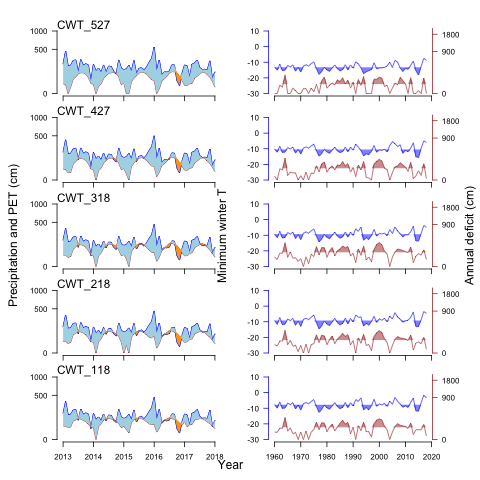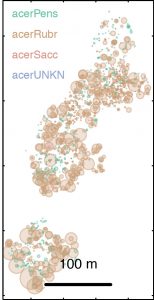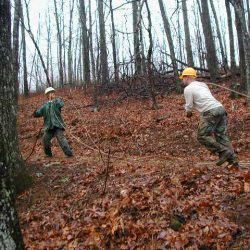Coweeta (CWT)
1992 – present
Coweeta has been a USFS Experimental Forest since 1934. In recent decades it has hosted the Coweeta LTER. Long-term demographic studies began in 1992, including seed traps, and sampling continues to the present. Logistics at the site have been facilitated by Jim Vose, Chelcy Miniat, and Jason Love. PhD theses using the long-term demographic data include those of Brian Beckage, Dave Bell, Mike Dietze, Janneke HilleRisLambers, Ines Ibanez, Emily Moran, and Mike Wolosin.
The watershed extends from Piedmont forests to northern hardwoods at the highest elevations. Moisture gradients span xeric Pinus rigida stands to riparian forest. Long-term demography began with the installation of “gradient” plots (CWT118, …, CWT527) in 1992, to be followed by experimental “gap” plots in 2000. Seedling experiments (Beckage, Ibanez) and microsatellite studies (Moran) were conducted on gap sites.

| tree_years | seed_count | |
|---|---|---|
| amelArbo | 832 | 0 |
| amelUNKN | 0 | 26 |
| betuAlle | 0 | 2 |
| betuLent | 156 | 283 |
| betuUNKN | 0 | 1586 |
| caryOvalGlab | 1482 | 0 |
| caryTome | 52 | 0 |
| caryUNKN | 0 | 78 |
| cornFlor | 1222 | 81 |
| faguGran | 312 | 0 |
| liriTuli | 338 | 0 |
| magnAcum | 182 | 0 |
| magnFras | 1430 | 0 |
| magnUNKN | 0 | 2 |
| nyssSylv | 2756 | 0 |
| oxydArbo | 1742 | 0 |
| pinuRigi | 936 | 246 |
| pinuStro | 78 | 0 |
| pinuUNKN | 0 | 224 |
| querAlba | 390 | 58 |
| querCocc | 1222 | 0 |
| querFalc | 0 | 41 |
| querMari | 104 | 0 |
| querPrin | 2470 | 7 |
| querRubr | 390 | 23 |
| querUNKN | 0 | 612 |
| querVelu | 1326 | 81 |
| robiPseu | 364 | 0 |
| sassAlbi | 2496 | 0 |
| tsugCana | 208 | 0 |
The following sites occupy control watershed 18, the Grady Branch Watershed, which has been undisturbed since 1927:
CWT-118 is a xeric ridge supporting mature Pinus rigida dating to past fire, with a dense understory of Quercus spp. and Kalmia latifolia. Part of plot was destroyed by establishment of a landing for a logging operation, but most remains intact.
| tree_years | seed_count | |
|---|---|---|
| amelArbo | 78 | 0 |
| amelUNKN | 0 | 10 |
| betuAlle | 26 | 142 |
| betuLent | 1040 | 5774 |
| betuUNKN | 0 | 35703 |
| caryOvalGlab | 910 | 0 |
| caryUNKN | 0 | 126 |
| cornFlor | 2002 | 16 |
| faguGran | 26 | 0 |
| ilexMont | 26 | 0 |
| ilexUNKN | 0 | 4 |
| liriTuli | 1872 | 0 |
| magnAcum | 52 | 0 |
| magnFras | 2132 | 0 |
| magnUNKN | 0 | 3 |
| nyssSylv | 572 | 0 |
| oxydArbo | 1248 | 0 |
| pinuRigi | 0 | 7 |
| pinuStro | 754 | 0 |
| pinuUNKN | 0 | 9 |
| querAlba | 0 | 9 |
| querCocc | 182 | 0 |
| querFalc | 0 | 29 |
| querPrin | 962 | 65 |
| querRubr | 104 | 14 |
| querUNKN | 0 | 186 |
| querVelu | 182 | 18 |
| robiPseu | 130 | 0 |
| sassAlbi | 156 | 0 |
| tiliAmer | 182 | 2024 |
| tsugCana | 780 | 0 |
CWT-218 is a sheltered cove site, dominated by Quercus spp., Liriodendron, Fraxinus, and Betula lenta. This mesic forest has some recruitment of Pinus strobus in the understory.

| tree_years | seed_count | |
|---|---|---|
| amelArbo | 260 | 0 |
| betuAlle | 26 | 4 |
| betuLent | 338 | 1907 |
| betuUNKN | 0 | 15964 |
| caryOvalGlab | 1196 | 0 |
| caryUNKN | 0 | 257 |
| cornFlor | 702 | 2 |
| fraxAmer | 26 | 3 |
| liriTuli | 312 | 0 |
| magnAcum | 26 | 0 |
| magnUNKN | 0 | 26 |
| nyssSylv | 2808 | 0 |
| oxydArbo | 2054 | 0 |
| querAlba | 0 | 26 |
| querCocc | 26 | 0 |
| querFalc | 0 | 31 |
| querPrin | 2730 | 111 |
| querRubr | 546 | 46 |
| querUNKN | 0 | 163 |
| querVelu | 156 | 6 |
| robiPseu | 78 | 0 |
| sassAlbi | 52 | 0 |
| tsugCana | 234 | 0 |
CWT-318 is a mixed hardwood stand, with a dense Rhododendron understory on steep terrain. It is dominated by Quercus spp. and includes Nyssa sylvatica.
The following sites occupy control watershed 27, the Hard Luck Creek Watershed. This has been a control watershed at least since 1946.
| tree_years | seed_count | |
|---|---|---|
| amelArbo | 130 | 0 |
| amelUNKN | 0 | 3 |
| betuAlle | 0 | 12 |
| betuLent | 104 | 778 |
| betuUNKN | 0 | 3858 |
| caryOvalGlab | 442 | 0 |
| caryUNKN | 0 | 34 |
| cornFlor | 260 | 5 |
| fraxAmer | 52 | 4 |
| ilexMont | 260 | 3 |
| ilexUNKN | 0 | 4 |
| liriTuli | 260 | 0 |
| magnAcum | 26 | 0 |
| magnFras | 650 | 0 |
| magnUNKN | 0 | 8 |
| nyssSylv | 3380 | 0 |
| oxydArbo | 2522 | 0 |
| querAlba | 0 | 116 |
| querCocc | 390 | 0 |
| querFalc | 0 | 97 |
| querPrin | 2782 | 183 |
| querRubr | 1196 | 137 |
| querUNKN | 0 | 1641 |
| querVelu | 260 | 72 |
| robiPseu | 260 | 0 |
| sassAlbi | 234 | 0 |
| tsugCana | 2028 | 0 |
CWT-427 occupies a higher elevation, also on a slope. It is contiguous with CWT-UG, which was installed later and includes experimental gaps.
| tree_years | seed_count | |
|---|---|---|
| amelArbo | 494 | 0 |
| amelUNKN | 0 | 17 |
| betuAlle | 4680 | 3155 |
| betuLent | 1534 | 59108 |
| betuUNKN | 0 | 443573 |
| caryOvalGlab | 52 | 0 |
| caryUNKN | 0 | 15 |
| cornFlor | 130 | 1 |
| faguGran | 780 | 0 |
| fraxAmer | 1742 | 5432 |
| ilexMont | 3822 | 0 |
| ilexUNKN | 0 | 6 |
| magnAcum | 52 | 0 |
| magnUNKN | 0 | 2 |
| oxydArbo | 26 | 0 |
| prunSero | 26 | 0 |
| querAlba | 26 | 18 |
| querFalc | 0 | 173 |
| querPrin | 0 | 2 |
| querRubr | 598 | 300 |
| querUNKN | 0 | 1697 |
| querVelu | 26 | 0 |
| tiliAmer | 3432 | 1355 |
| tsugCana | 78 | 0 |
CWT-527 is a northern hardwoods stand, dominated by Acer saccharum and Betula alleghaniensis.
These sites occupy watershed 28, which accommodates manipulative experiments:
CWT-LG occupies a hill slope dominated by Quercus spp., Liriodendron, Nyssa sylvatica, and Acer rubrum. It includes experimental gaps, 30 m in diameter, installed in 2000.
| tree_years | seed_count | |
|---|---|---|
| amelArbo | 1377 | 0 |
| amelUNKN | 0 | 6 |
| betuAlle | 187 | 20 |
| betuLent | 1921 | 1565 |
| betuUNKN | 0 | 4203 |
| caryOvalGlab | 3213 | 0 |
| caryTome | 1224 | 0 |
| caryUNKN | 952 | 64 |
| cornAlte | 68 | 0 |
| cornFlor | 2244 | 5 |
| faguGran | 255 | 0 |
| fraxAmer | 1819 | 5 |
| ilexMont | 187 | 0 |
| ilexUNKN | 0 | 8 |
| liriTuli | 23103 | 0 |
| magnAcum | 1955 | 0 |
| magnFras | 5491 | 0 |
| magnUNKN | 0 | 2 |
| nyssSylv | 5746 | 0 |
| oxydArbo | 2975 | 0 |
| prunSero | 102 | 0 |
| prunUNKN | 51 | 0 |
| querAlba | 51 | 66 |
| querCocc | 765 | 17 |
| querFalc | 0 | 51 |
| querPrin | 3927 | 65 |
| querRubr | 17238 | 209 |
| querUNKN | 0 | 480 |
| querVelu | 2516 | 23 |
| robiPseu | 1564 | 0 |
| sassAlbi | 1394 | 0 |
| tiliAmer | 34 | 54 |
| tiliHete | 306 | 0 |
| tsugCana | 4352 | 0 |
| ulmuAlat | 0 | 1 |
| ulmuAmer | 17 | 0 |
CWT-UG, contiguous with CWT-427, is dominated by Quercus spp., Nyssa sylvatica, …. It includes canopy gaps installed in 2000.
| tree_years | seed_count | |
|---|---|---|
| amelArbo | 1955 | 0 |
| amelUNKN | 0 | 727 |
| betuAlle | 17 | 84 |
| betuLent | 1938 | 652 |
| betuUNKN | 0 | 5175 |
| caryOvalGlab | 204 | 0 |
| caryTome | 68 | 0 |
| caryUNKN | 68 | 14 |
| cornAlte | 17 | 0 |
| cornFlor | 153 | 5 |
| ilexMont | 1547 | 0 |
| ilexUNKN | 0 | 32 |
| liquStyr | 17 | 0 |
| liriTuli | 374 | 0 |
| magnAcum | 153 | 0 |
| magnFras | 510 | 0 |
| nyssSylv | 6579 | 0 |
| oxydArbo | 3536 | 0 |
| pinuTaed | 68 | 0 |
| pinuUNKN | 0 | 18 |
| prunPens | 68 | 0 |
| prunUNKN | 0 | 44 |
| querAlba | 0 | 23 |
| querCocc | 1309 | 0 |
| querFalc | 0 | 58 |
| querPrin | 3332 | 43 |
| querRubr | 1377 | 84 |
| querUNKN | 0 | 360 |
| querVelu | 272 | 42 |
| robiPseu | 714 | 0 |
| sassAlbi | 612 | 0 |
| tsugCana | 663 | 0 |

Climate data were obtained from stations along the LTER elevation gradient, the main CWT climate station, supplemented by precipitation data from the USFS.
Mast data are described in publications, including:
- Berdanier, A. and J.S. Clark. 2016. Divergent reproductive allocation trade-offs with canopy exposure across tree species in temperate forests. Ecosphere, DOI:10.1002/ecs2.1313.
- Bell, D.M. and J.S. Clark 2015. Seed predation and climate impacts on reproductive variation in temperate forests of the southeastern USA. Oecologia, 180, 1223–1234. bell2016
- Clark, J.S., D.M. Bell, M.C. Kwit, and K. Zhu. 2014. Competition-interaction landscapes for the joint response of forests to climate change. Global Change Biology, 20, 1979-1991.
- Clark, J.S., D. Bell, C. Chu, B. Courbaud, M. Dietze, M. Hersh, J. HilleRisLambers, I. Ibanez, S. L. LaDeau, S. M. McMahon, C.J.E. Metcalf, J. Mohan, E. Moran, L. Pangle, S. Pearson, C. Salk, Z. Shen, D. Valle, and P. Wyckoff. 2010. High dimensional coexistence based on individual variation: a synthesis of evidence. EM2010, 80, 569–608. EM2010appendix-A, EM2010appendix-B
- Clark, J.S. 2010. Individuals and the variation needed for high species diversity. Science 327, 1129-1132, science2010. scienceAppend2010
- Clark, J.S., S. LaDeau, and I. Ibanez. 2004. Fecundity of trees and the colonization-competition hypothesis, Ecological Monographs, 74:415-442. Appendix.
- Hille Ris Lambers, J. and J.S. Clark. 2003. Effects of dispersal, shrubs, and density-dependent mortality on seed and seedling distributions in temperate forests. Canadian Journal of Forest Research 33: 783-795.
- Clark, J.S., M. Silman, R. Kern, E. Macklin, and J. Hille Ris Lambers. 1999. Seed dispersal near and far: generalized patterns across temperate and tropical forests. Ecology 80:1475-1494.
- Clark, J. S., E. Macklin, and L. Wood. 1998. Stages and spatial scales of recruitment limitation in southern Appalachian forests. Ecological Monographs 68:213-235.



